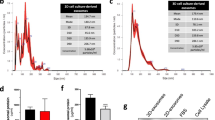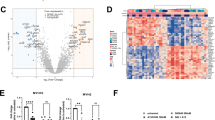Abstract
No measurable amounts of matrix metalloproteinases (MMPs) were produced by human breast adenocarcinoma cell lines MCF-7 and BT-20 in culture. When MCF-7 cells were co-cultured with human dermal fibroblasts enhanced production of precursors of MMP-1 (interstitial collagenase), MMP-2 (gelatinase A), MMP-3 (stromelysin 1) and tissue inhibitor of metalloproteinase type 1 (TIMP-1) was observed. Immunohistochemical studies indicated that these pro-MMPs originated primarily from the fibroblasts, suggesting that MCF-7 cells have a stimulatory effect on stromal cells to produce at least three pro-MMPs and TIMP-1. BT-20 cells also enhanced the production of pro-MMP-2 and TIMP-1 in the dermal fibroblasts, but not of pro-MMP-1 and pro-MMP-3. Normal mammary epithelial cells promoted only TIMP-1 production. To investigate further the stimulatory factors from MCF-7 cells, the conditioned medium and the cell membrane were prepared and examined. The cell membrane fraction enhanced the production of pro-MMP-1 and -3 and TIMP-1, but not of pro-MMP-2. The conditioned medium, on the other hand, augmented the production of all four proteins in the fibroblasts. These observations suggest that breast adenocarcinoma MCF-7 cells in culture produce both soluble and membrane-bound factor(s) which stimulate the production of pro-MMPs and TIMP-1 in neighbouring stromal cells, but the factor(s) released into the medium and that associated with cell membranes are probably different. Such communication between the normal and malignant cell types may, in part, assist the cancer cells to invade and metastasise.
This is a preview of subscription content, access via your institution
Access options
Subscribe to this journal
Receive 24 print issues and online access
$259.00 per year
only $10.79 per issue
Buy this article
- Purchase on Springer Link
- Instant access to full article PDF
Prices may be subject to local taxes which are calculated during checkout
Similar content being viewed by others
Author information
Authors and Affiliations
Rights and permissions
About this article
Cite this article
Ito, A., Nakajima, S., Sasaguri, Y. et al. Co-culture of human breast adenocarcinoma MCF-7 cells and human dermal fibroblasts enhances the production of matrix metalloproteinases 1, 2 and 3 in fibroblasts. Br J Cancer 71, 1039–1045 (1995). https://doi.org/10.1038/bjc.1995.200
Issue Date:
DOI: https://doi.org/10.1038/bjc.1995.200
This article is cited by
-
Intercellular interactions between mast cells and stromal fibroblasts obtained from canine cutaneous mast cell tumours
Scientific Reports (2021)
-
Extensive rewiring of epithelial-stromal co-expression networks in breast cancer
Genome Biology (2015)
-
Stromal fibroblasts in the microenvironment of gastric carcinomas promote tumor metastasis via upregulating TAGLN expression
BMC Cell Biology (2013)
-
IL-17 expression by breast-cancer-associated macrophages: IL-17 promotes invasiveness of breast cancer cell lines
Breast Cancer Research (2008)
-
Modulation of monocyte matrix metalloproteinase-2 by breast adenocarcinoma cells
Breast Cancer Research (2005)



